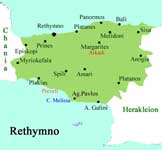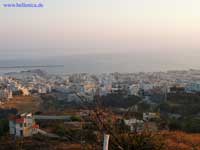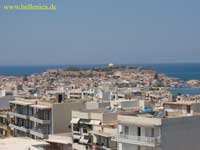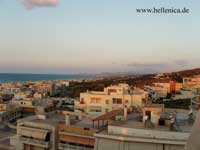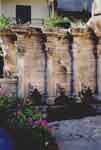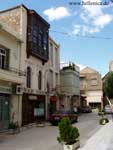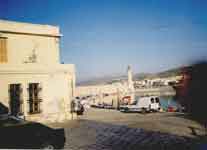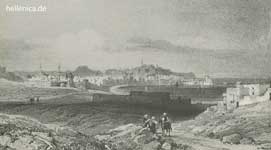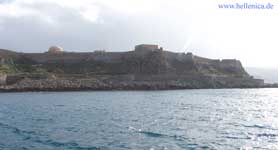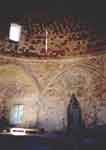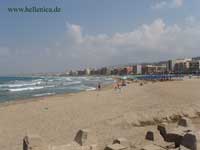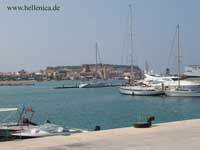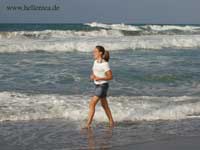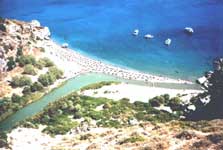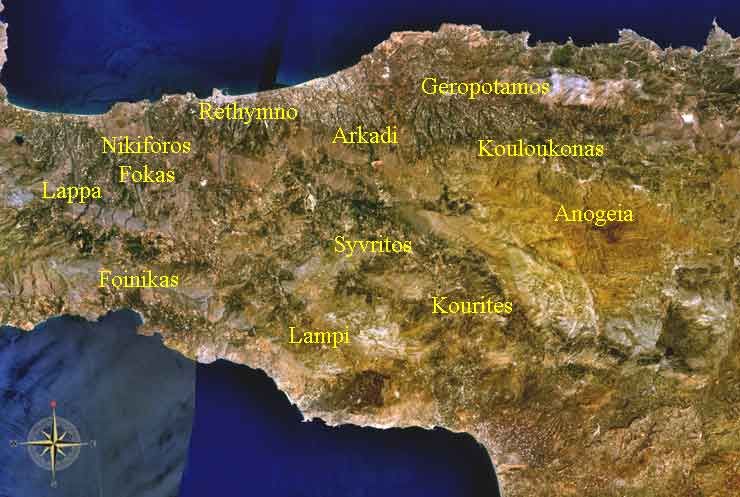.
Administrative Region : Crete
Regional unit : Rethymno
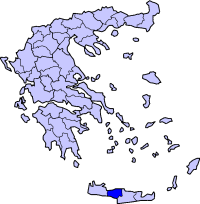
|
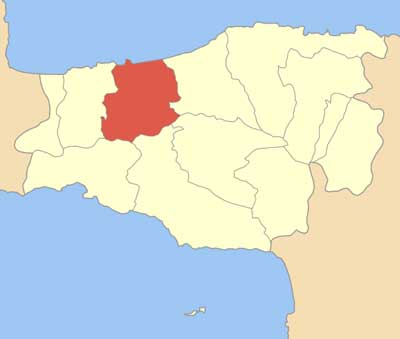 |
Rethymno (Greek: Ρέθυμνο, [ˈreθimno], also Rethimno, Rethymnon, Réthymnon, and Rhíthymnos) is a city of approximately 40,000 people in Greece, the capital of Rethymno peripheral unit in the island of Crete. It was built in antiquity (ancient Rhithymna and Arsinoe), even though was never a competitive Minoan centre. It was, however, strong enough to mint its own coins and maintain urban growth. One of these coins is today depicted as the crest of the town with two dolphins in a circle.
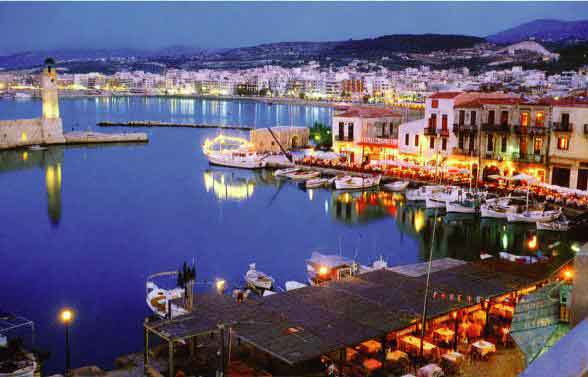
History
The main (eastern) gate of the fortress.
The Rimondi fountain.
This region as a whole is rich with ancient history, most notably through the Minoan civilisation centred at Kydonia east of Rethymno.[1] Rethymno itself began a period of growth when the Venetian conquerors of the island decided to put an intermediate commercial station between Heraklion and Chania, acquiring its own bishop and nobility in the process. Today's old town (palia poli) is almost entirely built by the Venetians. It is one of the best preserved old towns in Crete.
The town still maintains its old aristocratic appearance, with its buildings dating from the 16th century, arched doorways, stone staircases, Byzantine and Hellenic-Roman remains, the small Venetian harbour and narrow streets. The Venetian Loggia houses the information office of the Ministry of Culture. A Wine Festival is held there annually at the beginning of July. Another festival, in memory of the destruction of the Arkadi Monastery, is held on 7-8 November.
The city's Venetian-era citadel, the Fortezza, is one of the best-preserved castles in Crete. Other monuments include the Neratze mosque (the Municipal Odeon arts centre), the Great Gate (Μεγάλη Πόρτα, Porta Guora), the Piazza Rimondi (Rimondi square) and the Venetian Loggia.
The town was also captured by the Ottoman Turks in 1646 and was ruled by them for almost three centuries. The town (Resmo in Turkish) was the centre of a sanjak during Ottoman rule.
During the Battle of Crete (20-30 May 1941), the Battle of Rethymno was fought between German paratroopers and Australian and Greek forces. Although initially unsuccessful, the Germans won the battle after receiving reinforcements from Maleme in the Northwestern part of the island
Today the city's main income is from tourism, many new facilities having been built in the past 20 years. Agriculture is also notable, especially for olive oil and other Mediterranean products. It is also the base of the Philosophical School and the University Library of the University of Crete and the School of Social and Political Sciences having 8.000 students on its university campus per annum at "Galos", where the Academic Institute of Mediterranean Studies is situated. The city has an Archaeological Museum and a Historical and Folklore Museum.
Municipality
The municipality Rethymno was formed at the 2011 local government reform by the merger of the following 4 former municipalities, that became municipal units:[2]
Arkadi
Lappa
Nikiforos Fokas
Rethymno
Literature
Pandelis Prevelakis wrote Το χρονικό μιας πολιτείας (1937), The Chronicle of my Town, a nostalgic depiction of Rethymno from the period of the Cretan State (1898) to the expulsion of the Cretan Turks (1924).
Notable people of Rethymno
Marcus Musurus (1470–1517) scholar and philosopher
Ahmed Resmî Efendi Ottoman statesman, author and ambassador
Nick the Greek, poker player
Pandelis Prevelakis, (1909-1986) author of poetry, drama, essays, and studies.
Georgios Chortatzis, (1545–1610) Greek dramatist in Cretan verse.
International relations
See also: List of twin towns and sister cities in Greece
Rethymno is twinned with:
Russia Pushkin, Russia
Cyprus Ayia Napa, Cyprus
Italy Castenaso, Italy
Click image to enlarge
See also
History of Crete
List of settlements in the Rethymno prefecture
Municipal Gallery "L. Kanakakis"
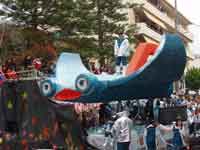
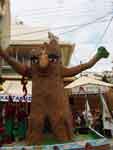
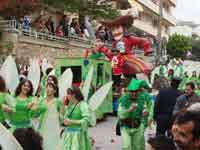
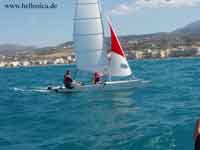
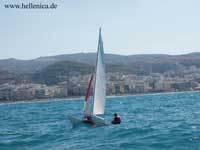

Preveli Beach, Preveli Bay Google Earth
References
Notes
^ C. Michael Hogan, Cydonia, The Modern Antiquarian, Jan. 23, 2008
^ Kallikratis law Greece Ministry of Interior (Greek)
|
Municipalities and communities of the Rethymno Prefecture
Anogeia | Arkadi | Foinikas | Geropotamos | Kouloukonas | Kourites | Lampi | Lappa | Nikiforos Fokas | Rethymno | Syvritos |
| Municipal unit Rethymno |
|---|
| Municipal Community Rethymno |
| Agia Eirini (Αγία Ειρήνη) |
| Anogeia (Ανώγεια, τα) |
| Gallos (Γάλλος, ο) |
| Giannoudi (Γιαννούδιον, το) |
| Μεγάλο Μετόχι, το |
| Mikro Metochi (Μικρό Μετόχι, το) |
| Ξηρόν Χωρίον, το |
| Rethymno (Ρέθυμνον, το) |
| Tria Monastiria (Τρία Μοναστήρια, τα) |
| Community Armenoi |
| Άγιος Γεώργιος, ο |
| Armenoi (Αρμένοι, οι) |
| Somatas (Σωματάς, ο) |
| Foteinos (Φωτεινός, ο) |
| Community Goulediana |
| Γενή, η |
| Goulediana (Γουλεδιανά, τα) |
| Community Kare |
| Ampelaki (Αμπελάκι, το) |
| Kare (Καρέ) |
| Community Kastellos |
| Kastellos (Κάστελλος, ο) |
| Community Koumes |
| Koumoi (Κούμοι, οι) |
| Community Maroulas |
| Dilofo (Δίλοφο, το) |
| Maroulas (Μαρουλάς, ο) |
| Community Oros |
| Oros (Όρος, το) |
| Community Prasies |
| Prasies (Πρασιαί, αι) |
| Community Roussospiti |
| Roussospiti (Ρουσσοσπίτιον, το) |
| Community Selli |
| Μύρθιος, η |
| Σελλίον, το |
| Community Chromonastiri |
| Kapediana (Καπεδιανά, τα) |
| Myloi (Μύλοι, οι) |
| Prinedes (Πρινέδες, οι) |
| Chromonastiri (Χρομοναστήριον, το) |
Greece :
A - B - C - D - E - F - G - H - I - J - K - L - M -
N - O - P - Q - R - S - T - U - V - W - X - Y - Z
| Ancient Greece
Science, Technology , Medicine , Warfare, , Biographies , Life , Cities/Places/Maps , Arts , Literature , Philosophy ,Olympics, Mythology , History , Images Medieval Greece / Byzantine Empire Science, Technology, Arts, , Warfare , Literature, Biographies, Icons, History Modern Greece Cities, Islands, Regions, Fauna/Flora ,Biographies , History , Warfare, Science/Technology, Literature, Music , Arts , Film/Actors , Sport , Fashion --- |
Retrieved from "http://en.wikipedia.org/"
All text is available under the terms of the GNU Free Documentation License


